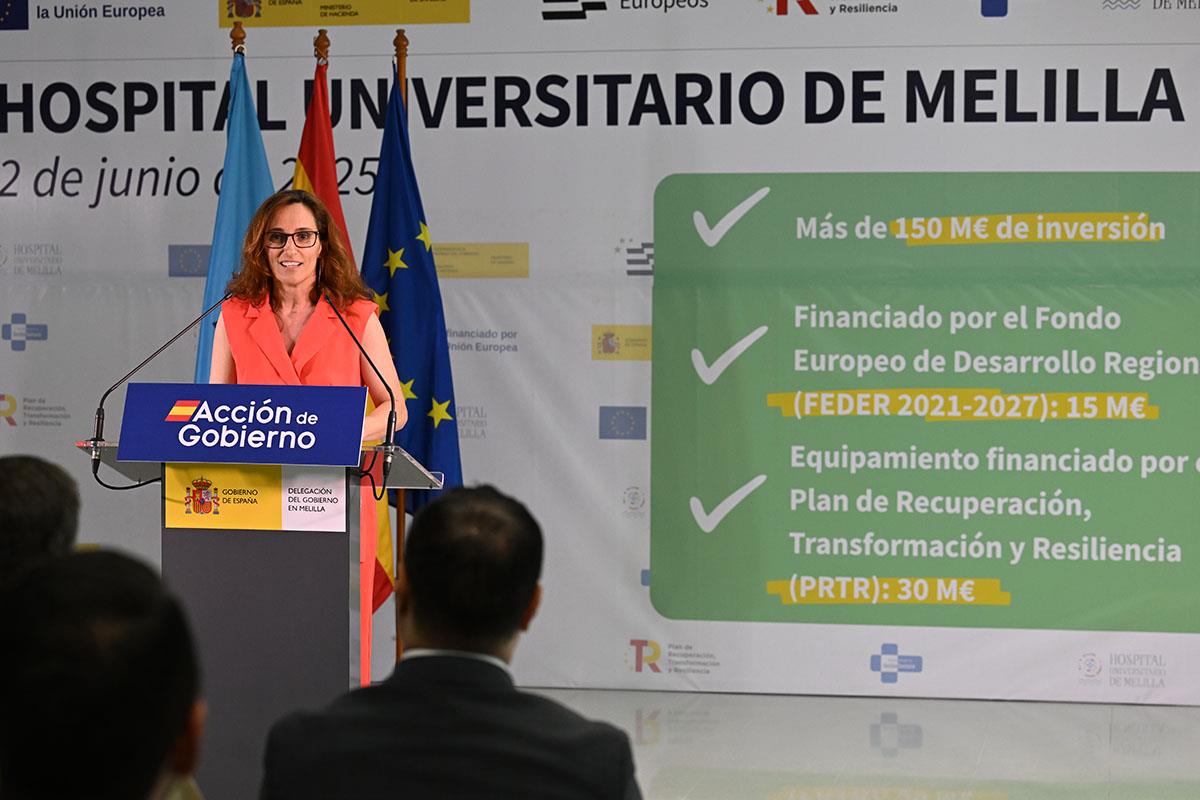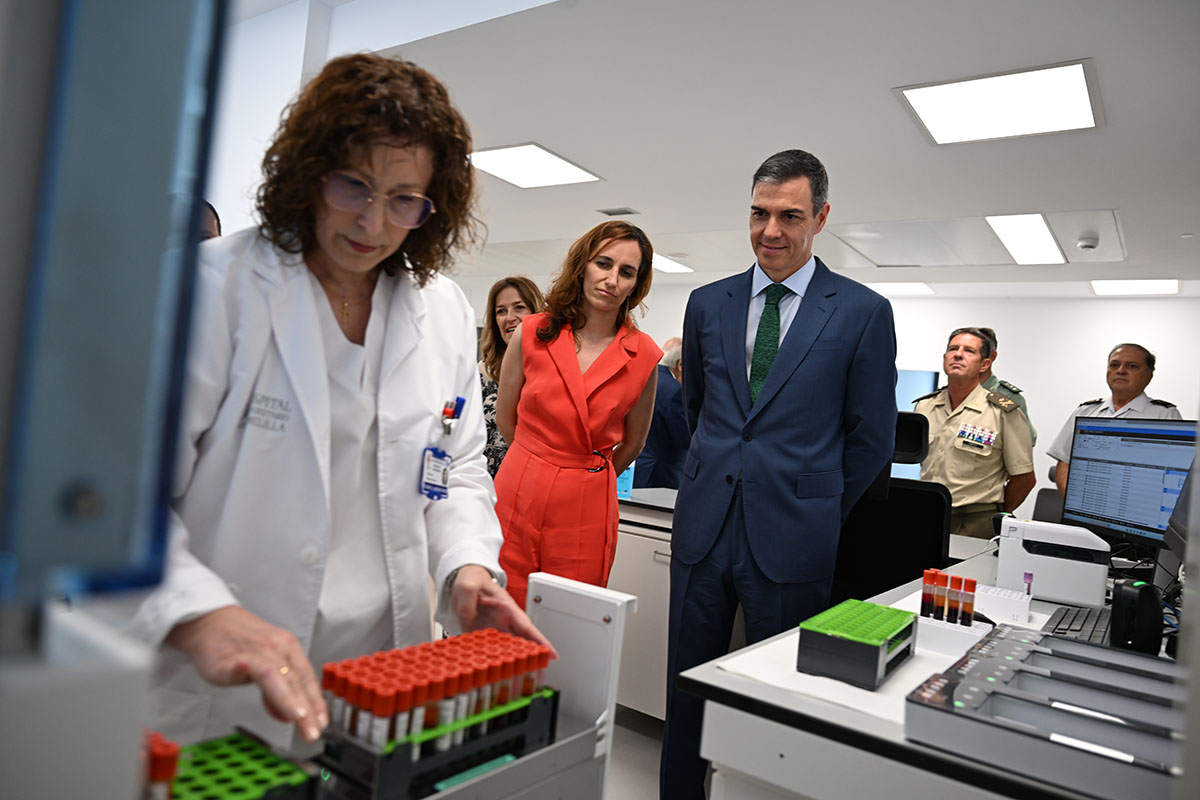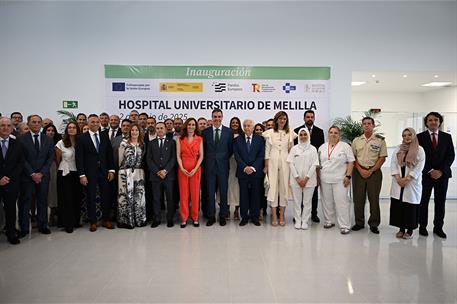The President of the Government of Spain and the Minister for Health inaugurate the new University Hospital of Melilla (HUME)
News - 2025.6.2

The President of the Government of Spain, Pedro Sánchez, and the Minister for Health, Mónica García, have inaugurated the University Hospital of Melilla (HUME), a benchmark health infrastructure that reinforces specialised care in the autonomous city.
The Minister for Health stressed that the new hospital has involved an investment of more than 150 million euros, has 265 beds, state-of-the-art healthcare technology and an expanded portfolio of services that will avoid unnecessary journeys outside the territory.
For his part, the president of the Government of Spain affirmed that this new infrastructure represents a firm commitment by the Executive to the city of Melilla, to improving the living conditions of its population and to public health as one of the fundamental pillars of the Welfare State.
Pedro Sánchez stressed that "the treasure of public health" is guaranteed by infrastructure such as HUME, with 265 beds, 45,000 m² of healthcare and state-of-the-art technology, including the paediatric ICU, the Haemodynamics Room, the hyperbaric chamber and robotic surgery.
He stated that "opening the doors of HUME repairs an injustice, it means settling a historical debt with the people of Melilla" and highlighted its role as a future reference centre in health training, at a time when the Ministry of Health has offered a record number of MIR places.
Finally, the president dedicated special recognition to "those who give their soul to these facilities, to its more than 1,100 professionals" and wished to honour the Gaza health workers, whose memory he recalled "on the shores of this same sea" that bathes Melilla, a "land full of history and, above all, of opportunities and future."
A before and after
The Minister for Health, Mónica García, emphasised that "as a doctor, I know very well how important it is that those who care can do so with a quality infrastructure," although it is within its walls that "the best values of our National Health System are to be found, those that make our public health system great: equity, cohesion, solidarity and social justice."
Mónica García expressed her sincere thanks to all the people and institutions that have made this milestone possible: to the professionals who have worked tirelessly in its design, construction, equipment and start-up, to the National Institute of Health Management and its director, Isabel Muñoz, and, in a very special way, to the European Union, for its decisive support through European funds.
Finally, the minister stressed that this new hospital is also an example of how we are moving towards a fairer and more cohesive public health system. Thanks to INGESA's framework agreements, we have brought cutting-edge technology not only to Ceuta and Melilla, but to the whole country, plans such as INVEAT, AMAT-I (High Technology Framework Agreement) have made it possible to reduce obsolescence, shorten the technological gap between territories and reinforce diagnostic capacity throughout the National Health System. And this has a very specific impact on people's lives: they are cared for sooner and they are cared for better.
"Today the new University Hospital of Melilla is up and running. But, above all, it sets in motion a better future for the health of this city and the country as a whole," concluded the Minister for Health.
Effective entry into service
 Pool Moncloa/Borja Puig de la Bellacasa
Pool Moncloa/Borja Puig de la Bellacasa
On 26 May, after obtaining the administrative licences, the new University Hospital of Melilla opened its doors to the public health service, managed directly by the Government of Spain. The opening marks an unprecedented milestone: the building meets the highest standards of efficiency, sustainability and accessibility, and places Melilla's specialised care at the forefront of the NHS.
The hospital incorporates innovations such as the INDEXOR system, already in operation in Primary Care (East Zone and Alfonso XIII Centres), which automates and improves the collection and management of samples. It also allows more tests and treatments to be carried out locally, avoiding trips to the mainland.
The transition from the Regional Hospital is carried out in phases, guaranteeing continuity of care. In this first stage, the outpatient clinics of multiple specialities (such as Rheumatology, Oncology, Neurology or Internal Medicine), the Rehabilitation Service, advanced radiological tests (MRI, CT, densitometry) and the new Clinical Analysis Laboratory, which places HUME among the most advanced in Spain, are already in operation.
A quantitative and qualitative leap
The University Hospital of Melilla represents a quantitative and qualitative advance for the local health system. With 45,000 m² of care area and 63,000 m² of floor space, the new building increases its capacity from 170 to 265 beds. The total investment was 150 million euros.
Thanks to the European Funds managed by INGESA, HUME incorporates state-of-the-art technology, including Magnetic Resonance Imaging, Paediatric ICU, Haemodynamic Room and Robotic Surgery, placing the hospital among the most advanced in the country.
These facilities make it possible to significantly expand the portfolio of services, avoiding trips to the mainland for tests such as catheterisation or MRI scans. In addition, the operation has been recognised as strategic in Spain's ERDF Multi-regional Programme 2021-2027.
The largest staffing level in its history
 The President of the Government of Spain, Pedro Sánchez, during his visit to the hospital laboratory, accompanied by the Minister for Health, Mónica García (Pool Moncloa/Borja Puig de la Bellacasa)
The President of the Government of Spain, Pedro Sánchez, during his visit to the hospital laboratory, accompanied by the Minister for Health, Mónica García (Pool Moncloa/Borja Puig de la Bellacasa)
The start-up of HUME is with the largest number of staff in the history of the public health system in Melilla, with around 1,100 professionals for a population of around 74,000. Between 2014 and 2024, the number of staff increased by 27% (229 more professionals), coinciding with a 34% reduction in care pressure due to the closure of borders.
The remuneration conditions of specialist doctors - the highest in the NHS - and the reduced pressure of care have favoured the recruitment of 30% more doctors, which translates into 52 additional specialists in the last decade.
In addition, HUME has allowed us to expand our teaching capacity, with more places in Family and Community Medicine, thus reinforcing the generational changeover and attracting highly qualified young professionals committed to teaching and research.
State-of-the-art technological innovation at the service of healthcare
The University Hospital of Melilla exemplifies the Government's drive to modernise healthcare technology. Since 2021, the Ministry of Health, through INGESA, has deployed plans such as INVEAT and AMATI-2024 to renew the SNS technology park. These initiatives, focused on high-tech diagnostic equipment, have involved investments of more than 1.1 billion euros and have generated significant savings for the autonomous communities. Thanks to these framework agreements, more than 3,200 pieces of equipment have been purchased, improving efficiency and reducing inequalities between territories.
Non official translation





